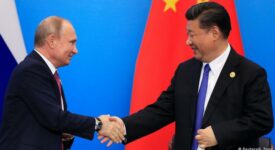From the release of the National Security Strategy at the end of 2017 through Vice President Mike Pence’s speech on 4 October 2018, to the administration’s imposition of 10 percent tariffs on $250 billion worth of Chinese exports and its global campaign against Chinese tech giant Huawei, the Trump administration has made clear that it sees China as the number one threat to US interests and its longstanding global pre-eminence. Importantly, their view is widely shared among both Republican and Democratic members of Congress, senior former officials in the Barack Obama and George W Bush administrations, labour unions and much of the US military.
In 2019, European governments will have to decide whether to side with the US in this new strategic stand-off or chart their own course. From the American perspective, the charge sheet against China is incontrovertible. China has illegally occupied, dredged and militarized a number of disputed reefs and islands in the South China Sea. Vice President Pence accused China of wanting ‘to push the United States of America from the western Pacific and to prevent us from coming to the aid of our allies’.
Most European governments take a more nuanced view of the China challenge. They share US concerns about the direction of China’s economy under President Xi, including forced technology transfer and unfair competition from state-owned and backed Chinese companies in China and globally. But, given their limited security interests in the wider Asia-Pacific region and far larger economic interests in China, Europeans principally fear the impacts of China’s rise on the international rule of law and democratic norms of governance.
European leaders criticize President Xi’s centralization of political power and suppression of even the mildest avenues of popular dissent, including the imprisonment of numerous human rights lawyers. The introduction of a nationwide digital citizens’ surveillance system by 2020 cuts against the grain of European protection of the privacy of individuals. And there is an echo of Soviet-era repression to China’s decision to build a series of re-education camps for hundreds of thousands of Uighurs in Xinjiang province.
European officials also resent China’s heavy-handed approach to its Belt and Road Initiative. Chinese loans to countries in Africa, Central Asia and Southeast Asia for BRI-related infrastructure have led to unsustainable debt levels and enabled China to foreclose on strategic ports and other assets. Chinese political and financial support for pliable governments along the BRI route risks entrenching corruption and undermining the rule of law in these countries. Moreover, China has also initiated a regular economic dialogue with sixteen Central and Eastern European countries that could benefit from its infrastructure investment. This ’16 + 1’ initiative is sowing new divisions within the EU and weakening its ability to hold some of its more authoritarian-minded EU governments to account.
But, despite these concerns, Europeans are avoiding the overt confrontation favoured by the White House. The more the Trump administration hardens its stance against China, the more the outlines of an alternative European approach are taking shape. Future US policymakers may come to rue the day when President Trump drove Europeans to develop their own ‘Europe First’ policy towards China, with more pragmatic, hard-nosed policies that suit their economic and strategic interests.
‘How Europe Will Try to Dodge the US–China Standoff in 2019’ – Expert Comment by Robin Niblett – Chatham House / The Royal Institute of International Affairs.
(The Expert Comment can be downloaded here)







